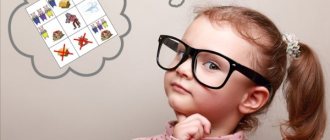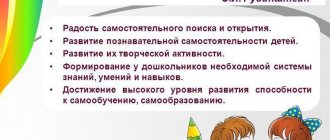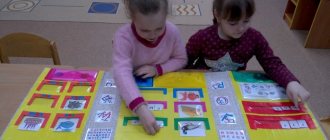MAGAZINE Preschooler.RF
Visual modeling as an effective means of mental development of preschool children- Kharchenko Anna Vladimirovna, Teacher of the Irkutsk Municipal Budgetary Educational Institution, Kindergarten No. 75;
- Shatokhina Marina Gennadievna, Teacher of the Irkutsk Municipal Budgetary Educational Institution, Kindergarten No. 75
The modern world is changing very quickly. Everything changes along with it, including thinking. The task of today's students is not simply to acquire knowledge, but to be able to obtain it independently and operate with it. Therefore, modern pedagogy is looking for opportunities to use the hidden reserves of children’s mental activity, ways of the most effective learning. The learning process, of course, should be as visual and as dynamic as possible. It should be noted that one of these ways to develop children's interest in learning is modeling.
Modeling is a visual and practical teaching method. A model is a generalized image of the significant properties of the object being modeled (room plan, geographic map, globe, etc.). The modeling method was developed by D. B. Elkonin, L. A. Wenger, N. A. Vetlugina, N. N. Poddyakov. Its essence lies in the development of a child’s thinking with the help of special schemes, models, which in a visual and accessible form reproduce the hidden properties and connections of a particular object.
In preschool pedagogy, there are three types of models:
- Subject model. This can be a physical structure, an object or objects that are naturally connected with each other. The model is an analogue of the object and reproduces its main connections and features.
- Subject-schematic model. In this case, essential components and connections between them are indicated using substitute objects and graphic signs. This model shows connections in a generalized form.
- Graphic model. Generally conveys different types of relationships, represents a graph, diagram, map, etc.
Visual modeling techniques include: substituents, pictograms, mnemonic tables.
In substitution, some objects are replaced by others. As a rule, paper squares, circles, ovals, different in color and size, are used as substitutes, since the substitution is based on some difference.
A pictogram is a symbolic image that replaces a word. This modeling technique refers to non-verbal means of communication and can be used in the following cases:
- when the child does not yet speak, but will soon master speech;
- for constant communication with a child who is unable to speak at all;
- to facilitate speech development;
- as preparation for mastering writing and reading;
- as a means of helping to express thoughts orally.
Mnemonic tables are diagrams that contain some information. The essence of the mnemonic diagram is this: for each word or small phrase you need to come up with some kind of picture; thus, the entire text is sketched schematically. The child will remember information much faster by looking at these diagrams and drawings. Therefore, we can say that mnemonic diagrams are a kind of memorization tool.
Many researchers believe that the modeling method can be used in various types of children's activities (N. N. Kondratyeva, M. V. Krulekht, A. K. Matveeva, T. D. Richterman, O. N. Somkova, etc.).
Indeed, modeling can be used everywhere - in mathematical and speech development, when familiarizing with fiction, in visual arts and when getting to know the world around us. The teacher is always looking for new ways and techniques that help make it easier for children to learn new material. Visual modeling is an excellent teacher’s assistant. It develops cognitive interest, teaches children to highlight the main idea, systematize their knowledge, and also helps prevent fatigue.
Using the visual modeling method in preschool education is very effective. After all, children understand various schematic images easily and quickly and use them successfully in the future. Older preschoolers only need one explanation to understand what a floor plan is, and they will freely find an object hidden in the room, focusing on the marks on the plan. Children easily recognize schematic representations of objects, use a map-type diagram to choose the right path in an extensive system of paths, etc.
It is known that it is easier for a child to learn many types of knowledge in the form of actions with models, rather than on the basis of a verbal explanation from an adult. For example, when forming mathematical concepts, it is extremely difficult for children to become familiar with the relationships between the part and the whole. Verbal methods in this case are not as effective as schematic images: when using visual modeling, children easily understand that a whole object can be divided and restored from parts.
What goals should a teacher pursue when using visual modeling in his work? First of all, develop cognitive interest, teach children to independently obtain information. The visual modeling method allows preschoolers to conduct research, make comparisons, and draw conclusions.
Practice shows that the use of modeling helps children easily navigate the sign system and coding methods, improves oral speech, promotes the development of logical and figurative thinking, memory, and attention. It also forms ideas about the world around us, work, etc.
Thus, we can say that modeling is one of the most effective methods of mental education of preschool children, since their thinking is characterized by objective imagery and visual concreteness. Therefore, it is possible and necessary to use the modeling method in the practice of preschool education. Teachers should not be afraid to use this technique, as it produces tangible results.
| Next > |
WHAT IS MODELING?
Modeling is considered as a joint activity of the teacher and children in constructing, selecting and constructing models.
The purpose of modeling is to ensure that children successfully master knowledge about the characteristics of natural objects, the world around them, their structure, connections and relationships that exist between them. Modeling is based on the principle of replacing real objects with objects depicted schematically or with signs. The model makes it possible to create an image of the most significant aspects of an object and abstract from the unimportant in this particular case.
As children understand the method of substituting signs, connections between real objects and their models, it becomes possible to involve children in joint modeling with the teacher, and then in their own modeling.
In the process of modeling surrounding objects, orienting activity is improved, perceptual and practical actions are formed.
USING VISUAL MODELING IN THE CORRECTION PROCESS
The use of visual modeling in the correctional process corresponds to one of the basic principles of correctional pedagogy - the principle of a workaround. Relying on primarily preserved visual perception and visual-figurative thinking formed by older preschool age, we form speech, bypassing the leading but impaired functions of the speech-auditory and speech-motor analyzers. In addition, the active use of visual modeling as a teaching method forms and improves the very mental ability of visual modeling, which is revealed when solving a wide range of both speech and intellectual problems.
Currently, in connection with the introduction of the Federal State Educational Standard, a number of researchers are considering visual modeling as one of the universal educational activities. The use of visual models in the correction process in itself is not an innovation, however, the development of visual modeling as an independent intellectual ability within the framework of speech activity is a more modern approach in education.
In speech therapy work, modeling acts as a specific method of cognition, on the one hand, and, on the other, as a program for analyzing new phenomena.
OVERCOMING VIOLATIONS OF LEXICAL AND GRAMMARICAL STRUCTURE OF SPEECH
| LEXICAL AND GRAMMARICAL STRUCTURE | ||
| “From what, what juice?” | "Wild and Domestic Animals" | “Mom and Cubs”, “Call it Kindly” |
| "Build a Snowman" | "Transport Classification" | "The Journey of a Little Car" |
OVERCOMING VIOLATION OF THE SYLLABAL STRUCTURE OF THE WORD
Corrective work to overcome violations of the syllabic structure of words. Here we use graphic diagrams along with symbols. They gave good results in overcoming violations of the syllabic structure of words, in the formation of the lexical and grammatical structure of speech, teaching coherent speech, correcting phonemic underdevelopment and in preparing children for learning to read and write. Corrective work to overcome violations of the syllabic structure of words consists of the development of speech-auditory perception and speech-motor skills. Visual modeling allows children to imagine the structure of a word using syllable substitutes, determine the number of syllables, and relate the word to the syllable pattern.
| Syllabic structure of a word | |||
| "Collect a flower" | "Collect a flower" | «Match - fleece» | "Collect a flower" |
FORMATION OF PHONEMATIC PERCEPTION
The formation of visual modeling skills occurs in a certain sequence with a constant increase in the proportion of independent participation of preschoolers. When developing visual modeling skills, the following didactic tasks are solved:
Familiarity with the graphical method of presenting information.
Development of model deciphering skills.
Formation of independent modeling skills.
The formation of phonemic perception is one of the most difficult areas of work, requiring the search for new methodological ways.
The correctional task is to make the word, which the child perceives as an inextricably sounding complex, an object of special attention.
Based on the work experience of V.M. Akimenko on the use of sound articulation models, we use signs in classes - symbols of sound articulation. This helps us teach children to distinguish sounds in a word intonationally, name words with a given sound, find and correlate the position of a sound in a word, become familiar with vowels and consonants using graphic symbols, distinguish between hardness and softness of a sound, and identify a stressed vowel.
When studying sounds, we give children their characteristics - a description of articulatory and acoustic properties. For children these are abstract, invisible concepts. Therefore, visual support is needed in the form of graphic diagrams and symbols, based on which children can talk about any sound, can compare sounds and see them clearly. The sound structure of a word is modeled using letters. The implementation of this skill at the initial stage of learning to read and write occurs in two stages: first, the phonological structuring of the sound side of the word is performed, that is, the establishment of the temporal sequence of phonemes of which it consists, and then the transformation of the temporal sequence of phonemes into a spatial sequence of letters is carried out.
With the help of sound models, the child gives the characteristics of different sounds: vowel - consonant, consonant - voiced and voiceless, hard and soft, they learn to independently find common and different in the articulation and characteristics of sounds.
| AUDIO AUTOMATION AND SOUND ANALYSIS | |||||
| "Sound House" | "Place of sound in a word" | "Traffic light" | "Sound Mosaic" | "Pyramid" | "Hard-soft" |
| "First-last" | "Place of sound in a word" | "Collect a flower" | "Collect the letter" | "Read the diagram" | "Pick up the tracks" |
VISUAL MODELING CONSISTS OF THE FOLLOWING STEPS
Assimilation and analysis of sensory material.
At the initial stage of work, geometric figures are used as substitute symbols, their shape and color resembling the object being replaced, and a strip of multi-colored circles can be represented as models of a coherent statement.
Translating it into sign-symbolic language.
Any modeling begins with a simple substitution of objects, leading to the use of symbols and signs. It is visual models that are most applicable for classes with preschool children, because it is much easier for a child to imagine an object, to identify the relationships between objects, their connections, seeing them visually, and often taking part in their creation.
Working with the model.
At subsequent stages, children choose substitutes, without taking into account the external signs of the object, focused on qualitative characteristics (evil, kind, cowardly, etc.).
In order to develop modeling, as a rule, the reverse order is more appropriate, in which children first master the use of models and then their construction.
The most diverse and productive work is with model schemes for the development of coherent speech and creative storytelling. Modeling is quite common in various fields of scientific knowledge, including in special pedagogy, which develops theoretical and practical aspects of the education and upbringing of persons with disabilities in physical and mental development. Consequently, modeling in special pedagogy is a purposeful process of correcting mental (speech) and physical developmental disabilities in children by constructing and studying models of any phenomena, objects or systems.
TASKS
Purposefully develop children's impressive speech and generalize their active vocabulary.
Strengthen word formation skills, form and improve the ability to use various sentence structures in speech, describe objects, compose sentences, stories.
Use sound models during sound analysis (consonant, vowel, hard, soft, unvoiced, voiced, etc.), words (a certain symbol that indicates its beginning, middle and end).
Strengthen understanding of the meanings of parts of speech and grammatical categories through visual modeling.
Teach children to analyze, synthesize, abstract, compare, generalize, use various models, diagrams, mnemonic tables, signs, symbols.
MODELS USED
When using the visual modeling method, children become familiar with a graphical way of presenting information - a model. Symbols of various types can act as conditional substitutes (elements of the model):
- geometric figures;
- symbolic images of objects (symbols, silhouettes, contours, pictograms);
- plans and symbols, contrasting frame.
In the process of teaching coherent descriptive speech, modeling serves as a means of planning utterances. The visual modeling method can be used to work on all types of coherent monologue statements:
- retelling;
- compiling stories based on a painting and a series of paintings;
- descriptive story;
- creative story.
Elements of a story plan based on a landscape painting can be silhouetted images of its objects, both those clearly present in the painting and those that can be identified only by indirect signs.
The method is based on the use of a substitute (model), which can be other objects, realistic and conventional images, diagrams, drawings, plans, pictograms.
The following are used as substitute symbols when modeling creative stories:
- subject pictures;
- silhouette images;
- geometric figures.
A visual model of an utterance acts as a plan that ensures the coherence and sequence of the child’s stories. The use of a method of visual modeling of coherent utterances, the use of which increases children's interest in this type of activity and allows one to achieve significant results in correcting the speech of preschoolers.








